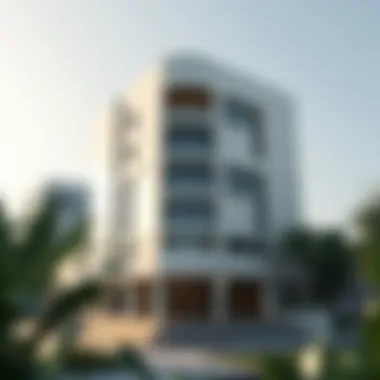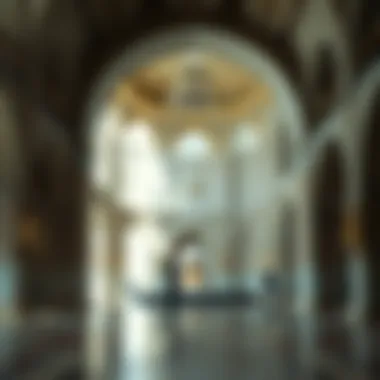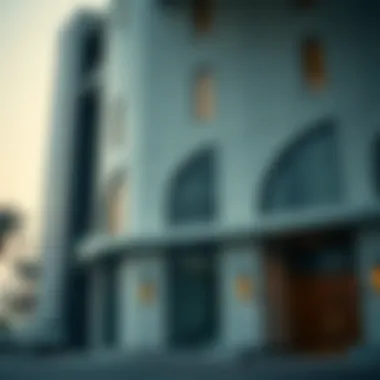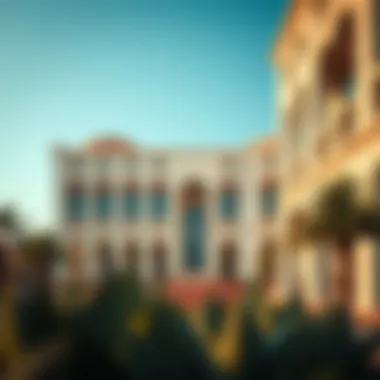Exploring the Architectural Significance of Ahmed Al Murr


Intro
The Ahmed Al Murr Building stands as a pivotal structure within Dubai's rapidly evolving skyline. More than just a piece of architecture, it represents a fusion of modern design and cultural expression that greatly contributes to the city's identity. Situated at the heart of Dubai, the building’s striking facade captures the eye of passersby while providing functional spaces for businesses and residents alike.
This article delves deep into the architectural significance of the Ahmed Al Murr Building, placing it within the larger context of Dubai's historical evolution. We will explore not merely its size and structure but the meticulously curated design elements that reflect both innovation and tradition.
Understanding the building's role in Dubai's real estate landscape is crucial for investors, homeowners, and even those curious about urban planning. We’ll analyze current trends in Dubai real estate, the factors driving property prices, and the investment opportunities arising from developments like this. Our exploration will reveal how structures like the Ahmed Al Murr Building do not simply occupy space; they shape the urban environment and influence the community’s dynamics.
In this narrative, we aim to combine technical details with insightful commentary that resonates with an audience looking for depth and understanding in modern architecture. The Ahmed Al Murr Building is not just a structure; it symbolizes the aspirations and progress of a city that continues to redefine itself in the global landscape.
Intro to the Ahmed Al Murr Building
The Ahmed Al Murr Building stands as a beacon of architectural merit, poised at the intersection of modernity and tradition in Dubai. Understanding this landmark is not just about appreciating its aesthetic appeal; it delves into the very fabric of the city’s urban evolution. This section introduces the building within the broader context of Dubai’s architectural landscape, serving as a prologue to the detailed exploration that follows.
A Brief Overview
Designed by the influential architect Ahmed Al Murr, this structure is a testament to innovative design and engineering. Completed in 2013, the building rises impressively above the Dubai skyline, showcasing intricate features that combine functionality with artistry. Architects and urban planners recognize its significance as it reflects the rapid development and aspirations of Modern Dubai.
Don’t get it twisted; this isn’t just another tall building in a city flooded with skyscrapers. Its unique façade and structural elements exemplify a fusion of local culture and advanced building techniques, encouraging conversations among property investors, real estate agents, and architecture aficionados alike.
Location and Context
Nestled in the bustling heart of Dubai’s financial district, the Ahmed Al Murr Building benefits from a prime spot that amplifies its importance. Positioned near landmarks such as the Burj Khalifa and the Dubai Mall, it plays a pivotal role in the urban fabric of the city.
This central location enhances its visibility, drawing the attention of businesses and tourists alike, fostering an environment ripe for economic activity. Furthermore, its proximity to major transport links makes it a hub of connectivity, easing accessibility for residents and visitors.
Moreover, the location is steeped in history; it stands as a reminder of Dubai's transformative journey from a modest trading port to a global commercial center. The community surrounding the Ahmed Al Murr Building exemplifies modern urban living, melding luxury with practical residential spaces, thereby enriching the lives of those who call this vibrant city home.
Architectural Design
The architectural design of the Ahmed Al Murr Building stands as a testament to innovation and cultural expression within the bustling urban tapestry of Dubai. Its significance reaches far beyond mere aesthetics. This section delves into the essential components that contribute to the building's character, the rationale behind form and function, and the broader implications of its design on both the community and potential investors.
Structural Features
The structural features of the Ahmed Al Murr Building are nothing short of remarkable. At first glance, the distinctive skyline silhouette draws attention, characterized by clean lines and modern geometrical shapes. The use of cantilevering elements not only adds visual intrigue but also maximizes usable space, both internally and externally. This architectural choice minimizes the building's footprint, allowing for an expansive yet efficient design that reflects modern urban living.
Natural light is strategically harnessed through expansive floor-to-ceiling windows, integrating outdoor views and enhancing interior environments. This brings not just illumination but also a sense of well-being to occupants, fostering productivity and comfort. Furthermore, the building's foundation is engineered to withstand the sandy soil conditions typical of Dubai's landscape, showcasing the foresight of its designers.
Innovative Materials Used
In the realm of construction, materials can often dictate the overall success of a building's design. The Ahmed Al Murr Building employs a mix of traditional and modern materials that epitomize the fusion of the old with the new. For instance, locally sourced limestone is used for its façade, connecting the structure to Dubai's geographical and historical context. At the same time, incorporating elements like high-performance glass ensures energy efficiency, contributing to a reduced carbon footprint.
Additionally, the use of lightweight steel framing allows for larger open spaces within. This not only boosts design flexibility but also facilitates faster assembly, minimizing construction time. Such material choices highlight how sustainability can be carefully wed together with aesthetic appeal.
Influences and Inspirations


The design of the Ahmed Al Murr Building reflects a confluence of influences that mirror Dubai’s identity as a global hub. Inspired by ancient Islamic architecture, the building incorporates mashrabiya-inspired elements, which serve as both privacy screens and intricate patterns that break up the sunlight, fostering a comfortable interior environment. This nod to cultural heritage showcases a deep respect for local traditions while embracing the future.
Moreover, the building also draws from the ethos of contemporary architectural movements. The minimalist aesthetic often associated with Scandinavian architecture plays a role here. Clear, uncluttered spaces and functional design promote a lifestyle that resonates with modern sensibilities. Such a balance of influences not only creates a unique architectural statement but also resonates with diverse demographics, making it appealing to both local and expatriate communities.
"Architecture is the art of how to waste space." – Philip Johnson
Historical Significance
The historical significance of the Ahmed Al Murr Building extends beyond its physical attributes, encompassing cultural and socio-economic narratives that intertwine with its existence in Dubai. This section delves into the construction history, cultural context, and a timeline of key events related to the building, illustrating its integral role in the urban fabric of the city and the broader narrative of the region.
Construction History
The Ahmed Al Murr Building first broke ground in the early 20th century, a period marked by transformation in Dubai’s architectural landscape. The construction process began in 2006 and concluded in mid-2009, reflecting a combination of modern engineering techniques and traditional building methods. Notably, the architectural team behind this structure emphasized the importance of local craftsmanship, which resulted in a melding of contemporary style with classical motifs.
Through its construction, the building symbolized the rapid growth of Dubai as it evolved from a small trading port into a global metropolis. It served not just as a structure but as a beacon of ambition signifying the potential of Dubai's skyline that continues to attract both tourists and investors.
"The Ahmed Al Murr Building is not just a place but a reflection of the spirit of innovation that courses through Dubai."
Cultural Context
Situated at the heart of a vibrant urban environment, the Ahmed Al Murr Building captures a slice of Dubai’s rich cultural tapestry. Its design echoes the local environment and historical influences, including the influence of Islamic architecture, which is characterized by intricate geometric patterns and ornate facades.
Moreover, the building acts as a cultural hub, hosting numerous events and exhibitions that celebrate Emirati traditions and arts. This cultural engagement has made it a central point for community gatherings, thus fostering a sense of belonging among its residents and visitors.
Timeline of Key Events
To truly grasp the historical significance of the Ahmed Al Murr Building, one must consider key events leading to its construction and subsequent developments.
- 2005: Initial conceptualization of the project, aiming to enhance Dubai’s architectural diversity.
- 2006: Official groundbreaking ceremony, signaling the start of construction.
- 2008: Progress milestone with the building reaching its structural peak; local artisans employed in the finishing touches.
- 2009: Grand opening; the building starts to host art exhibits and community events.
- 2011: The building receives an award for architectural excellence, affirming its place in Dubai's modern history.
Each of these events has contributed to the building's legacy, linking its physical presence to the ongoing narrative of cultural and economic evolution in Dubai. The Ahmed Al Murr Building, through its historical significance, offers insights not just into architecture, but also into the very essence of Dubai’s identity and its aspirations.
Economic Impact
The economic impact of the Ahmed Al Murr Building extends far beyond its impressive façade; it resonates deeply within the fabric of Dubai's growth narrative. Considered a landmark in the city, the building influences not just real estate values but also serves as a catalyst for broader economic activities. Understanding its economic implications is crucial for potential investors, local businesses, and the community alike.
Real Estate Market Trends
Following the completion of the Ahmed Al Murr Building, the Dubai real estate market has experienced marked shifts. Notably, the building's unique design and strategic location have driven demand in the surrounding areas.
- Price Surge: The vicinity has seen property prices climb steadily, with interest peaking among buyers eager to capitalize on nearby developments. This trend reflects a broader confidence in the area, fostering a competitive real estate environment.
- Increased Foot Traffic: With its commercial spaces attracting prominent businesses, foot traffic has surged, lending vitality to nearby retail outlets and services. This dynamic has led to growth in occupancy rates for both commercial and residential properties.
- Development Focus: More projects have sprung up as developers look to mirror the success of the Ahmed Al Murr Building, redefining the skyline and increasing the appeal of the neighborhood.
Investment Opportunities
The potential for investment around the Ahmed Al Murr Building is significant and multifaceted. For investors, there are several considerations:


- Commercial Spaces: The rise in employment opportunities thanks to companies setting up shop in the building has spurred the demand for nearby commercial real estate. Acquiring properties near the building can yield lucrative rental income and appreciation in the long term.
- Sustainable Ventures: As expectations around sustainability grow, developers now seek to incorporate green building practices in projects nearby, presenting eco-conscious investors with attractive options.
- Mixed-Use Developments: The trend toward mixed-use spaces, combining residential, retail, and office units, presents promising avenues for investment, catering to the live-work-play environments that modern cities are gravitating towards.
Impact on Local Businesses
Local businesses have also felt the ripples of the Ahmed Al Murr Building's presence. The establishment’s influence is palpable:
- Increased Patronage: With higher foot traffic in the vicinity, local shops and eateries have reported a boost in sales, making it an optimal time for entrepreneurs to launch new ventures.
- Collaboration Opportunities: The proximity to significant corporate tenants fosters partnerships and collaborations, wherein local businesses can offer services or products, thus integrating into the economic ecosystem.
- Support for Employment: More businesses mean more hiring, which fuels the local economy. This influx of jobs has positive feedback, helping to uplift surrounding neighborhoods.
**"The Ahmed Al Murr Building is not just a structure; it’s a growth engine that shapes the economic landscape of Dubai’s property market and community."
In summary, the Ahmed Al Murr Building acts as a linchpin within Dubai's evolving economic framework. With its profound influence on real estate trends, opportunities for investment, and support to local businesses, the building highlights how architecture goes hand in hand with economic development.
Community Relevance
The Ahmed Al Murr Building holds a notable position within Dubai's urban fabric, establishing itself not just as an architectural marvel but also as a pivotal part of community engagement and development. Its significance extends beyond its beautiful façade and into the very essence of neighborhood dynamics, bridging gaps between various social groups while encouraging vibrant public participation.
Integration with Urban Development
The concept of integration with urban development lies at the heart of the Ahmed Al Murr Building’s mission. Placed strategically, the structure signals a commitment to enhancing the surrounding neighborhood. Developers have put thought into how this building interacts with its environment, ensuring it complements local infrastructure and contributes positively to the community.
With its mix of residential, commercial, and communal spaces, the building offers multiple avenues for interaction. Residents are presented with opportunities for socialization, commerce, and recreation right at their doorstep. For investors, this means an attraction of potential buyers looking for convenience coupled with community engagement.
"A building is only as good as the life it brings to its surroundings."
The layout of the Ahmed Al Murr Building embraces pedestrian accessibility. Sidewalks and public spaces around the building allow for both leisurely strolls and active gatherings. Parks and open areas have also been designed thoughtfully, providing a venue for local events like farmer's markets, exhibitions, or family-friendly activities that encourage community bonding. The connectivity to public transport hubs and major thoroughfares further enhances its appeal, attracting a diverse demographic while enriching neighborhood unity.
Social Engagement and Cultural Activities
Cultural activities within the Ahmed Al Murr Building act as a catalyst for social engagement. This is evident in the various programs and initiatives hosted onsite. Art exhibitions, workshops, and cultural festivals create a lively atmosphere, drawing not just locals but also tourists curious to partake in Dubai’s diverse cultural landscape.
Such activities invite creativity and foster dialogue among different generations, backgrounds, and interests. For those passionate about the arts, the building stands as a platform for emerging talent, paving the way for artistic dialogue and collaboration. Fluctuation of ideas in such a setting nurtures community spirit and allows residents to take pride in their locale.
Noteworthy is the encouragement of sustainability concepts within these events. Residents learn practical ways to conserve resources, minimize their ecological footprint, and celebrate local biodiversity through community-led initiatives. This cultivated awareness is beneficial for both the residents and the local businesses, which often collaborate on sustainability efforts, strengthening relationships and supporting the economy.
It represents an investment in social cohesion and cultural vibrancy, setting a benchmark for future developments in urban settings.
Environmental Considerations
Environmental considerations are becoming paramount in modern architecture, especially in a bustling metropolis like Dubai. The Ahmed Al Murr Building isn't just a marvel in design—it's a representation of how construction can align with the principles of sustainability and environmental stewardship. By addressing these elements, builders and investors can ensure that developments like this not only serve immediate urban needs but also contribute positively to the ecosystem.
Sustainable Practices in Construction
Sustainable construction practices in the Ahmed Al Murr Building are indicative of a broader trend within the industry to adopt eco-friendly methodologies. These practices encompass various strategies aimed at minimizing environmental impact.
- Energy Efficiency: The building integrates advanced energy-efficient systems, such as smart HVAC technology that adjusts heating and cooling based on occupancy. This leads to reduced energy consumption, benefitting both the environment and the bottom line for businesses operating within.
- Green Materials: Using locally sourced and recycled materials reduces carbon footprints and transportation emissions. Concrete mixes that include recycled aggregates and low-emission alternatives are findings common in this structure.
- Water Conservation: Innovative fixture designs are employed to ensure minimal water waste. Employing rainwater harvesting systems adds another layer of sustainability, allowing water reuse for irrigation and non-potable applications.


These sustainable practices not only help in lowering operational costs but also align with the demands of environmentally conscious investors, making the building more attractive in the long run.
Influence on Urban Ecology
The influence of the Ahmed Al Murr Building extends beyond its immediate footprint, contributing to urban ecology in Dubai in significant ways. The concept of urban ecology refers to the integration of nature within city environments, which is increasingly vital as cities expand.
- Green Spaces: The incorporation of green roofs and vertical gardens into the design fosters biodiversity. These spaces not only enhance aesthetics but also help in temperature regulation, thereby improving the microclimate around the building.
- Habitat Creation: The architectural design promotes habitats for various species, aiding in the restoration of fragmented ecosystems. This is especially crucial in urban settings where natural habitats are losing ground.
- Air Quality Improvement: The plants and greenery are not merely decorative; they actively contribute to improving air quality by absorbing pollutants. This aspect cannot be overstated, as clean air is a key factor in urban health.
"By embracing sustainable practices, the Ahmed Al Murr Building stands as a beacon for future developments, showcasing the potential for harmony between urban life and ecological preservation."
Through these elements, the Ahmed Al Murr Building epitomizes a forward-thinking approach to urban design, demonstrating how development can be both beneficial to businesses and considerate to the environment. This symbiotic relationship is what investors, buyers, and community members alike are starting to demand as cities continue to evolve.
Future Developments and Plans
The future of the Ahmed Al Murr Building resonates with exciting possibilities and opportunities for both its structural integrity and its role in Dubai's urban landscape. As Dubai continues to evolve, the significance of this building becomes even more pronounced. These prospective developments offer not only enhancements for the existing structure but also strategic benefits for investors and the community at large.
Expansion Projects
With the increasing demand for real estate in Dubai, the idea of expansion projects surrounding the Ahmed Al Murr Building is gaining traction. Considering its prime location, expansions could include residential complexes, office spaces, or retail units. These additions would not only enhance the area but also create a vibrant atmosphere.
- Mixed-Use Developments: Incorporating residential spaces along with commercial units can cater to the multifaceted needs of the community.
- Public Spaces: Plans for parks, plazas, or recreational areas around the building can foster social cohesion and friendly interactions among residents and visitors.
- Accessibility Improvements: Elevating transportation access through new routes or public transit connections can significantly increase foot traffic and visibility for businesses nearby.
By focusing on expansion, stakeholders can contribute to a thriving ecosystem that benefits all parties involved, from residents to investors.
Potential Upgrades and Restoration
As the saying goes, “A stitch in time saves nine,” and the Ahmed Al Murr Building is no exception. Regular upgrades and restoration efforts can extend its lifespan and maintain its aesthetic appeal. These are some key considerations:
- Modern Renovations: Updating facilities with smart technology can improve energy efficiency and usability for its inhabitants. This includes smart security systems, energy-efficient lighting, and water conservation efforts.
- Preservation of Historical Elements: Balancing modernization with the retention of the building’s historical aspects is imperative. Retrofitting historical components while ensuring compliance with contemporary standards can preserve the cultural narrative.
- Sustainability Initiatives: Implementing green roofs or solar panels and incorporating sustainable materials can align with global standards and expectations, primarily as the world shifts towards environmental responsibility.
The upgrade and preservation of the building not only safeguard its architectural significance but also attract a discerning clientele interested in investing in properties with legacy and modern relevance.
Investors should keep an eye on developments in and around the Ahmed Al Murr Building, as these initiatives can significantly influence property values and potential returns.
Such strategic initiatives involving expansion projects and upgrades can enhance the allure of the Ahmed Al Murr Building, making it an essential part of Dubai's future urban ecosystem. With careful planning and execution, the advantages are bound for investors, businesses, and the community alike.
Ending
In wrapping up our exploration of the Ahmed Al Murr Building, it's important to consider the myriad facets that contribute to its significance within the fabric of Dubai. A building is more than its walls and design; it serves as a reflection of its time—articulating stories of ambition, culture, and transformation. In this case, the Ahmed Al Murr Building encapsulates the ethos of modern architecture while grounding itself in historical significance.
Reflecting on the Building's Impact
The impact of the Ahmed Al Murr Building extends beyond aesthetic appeal. It stands as a symbol of innovation and serves as a cornerstone of local economic growth. For investors and real estate professionals, understanding this building's role offers insights that can inform strategic decision-making. The architectural features and materials not only showcase modern capabilities but also mirror the cultural narratives shaping Dubai.
- Cultural Fusion: The building harmonizes local traditions with contemporary design, making it a site that resonates with both residents and visitors.
- Economic Catalyst: It enhances local business activities by attracting tourism and new investments.
- Sustainability and Forward-Thinking: Integration of sustainable practices signifies a conscious shift toward environmentally responsible architecture.
In essence, these elements collectively highlight the Ahmed Al Murr Building as more than just a physical structure. It stands as a testament to Dubai's evolution, a touchstone for community engagement, and a beacon for future developments. Notably, it invites investors to think critically about long-term value and the role that architecture plays in shaping urban landscapes. This convergence of heritage, innovation, and economic impact paints a vivid picture of what the Ahmed Al Murr Building truly represents within the vibrant tapestry of Dubai’s urban environment.
As Dubai continues to evolve, the Ahmed Al Murr Building serves as a reminder that architecture is not simply about space—it is about creating environments that foster growth, culture, and community connection.
For further exploration on the architectural influence in Dubai, you might find these resources helpful:













